Politics
Leaked Map Shows California Democrats’ New Congressional Map That Eliminates 5 GOP House Seats
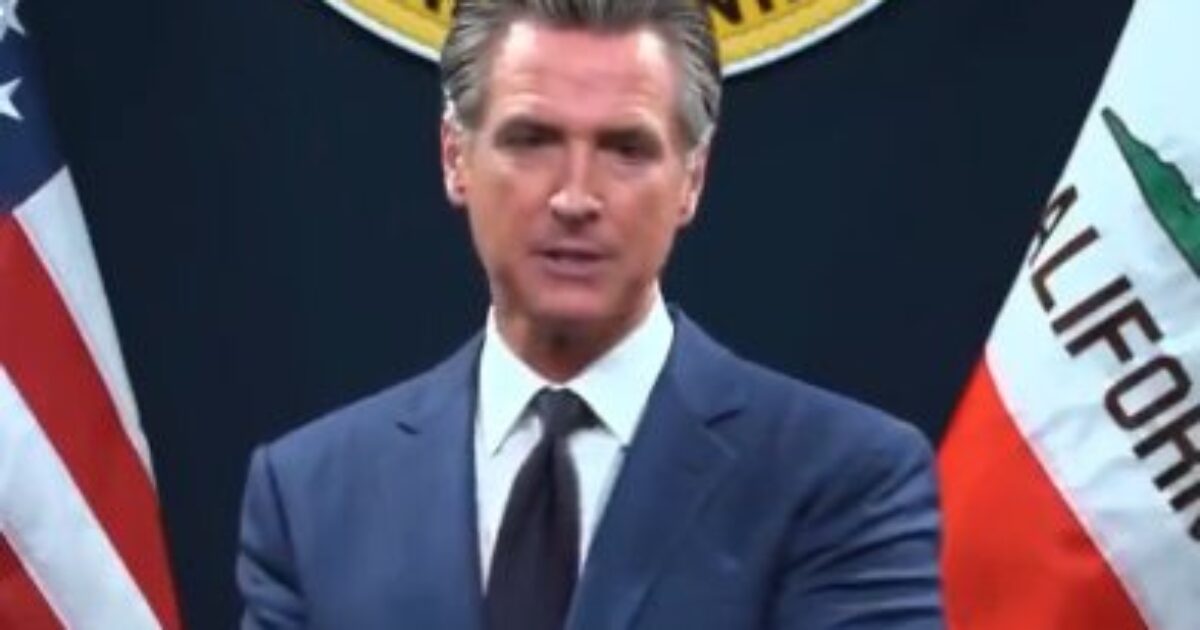
California Democrats on Friday rolled out their new Congressional map that eliminates 5 GOP House seats in response to the redistricting fight between Texas legislators.
California voters will decide in a special election this November on the new Congressional map.
Because of ballot harvesting, drop boxes, mail-in ballots without chain of custody and questionable ballot curing, the 2024 election gave California 43 Democrat House seats and 9 Republican seats.
Now the Democrats are trying to eliminate 5 more GOP House seats.
“The five California Republicans targeted by the redistricting plan include Representatives Doug LaMalfa in District 1, Kevin Kiley in District 3, David Valadao in District 22, Ken Calvert in District 41, and Darrell Issa in District 48,” KCRA reported.
The new map was leaked to KCRA, Politico and the Washington Post.
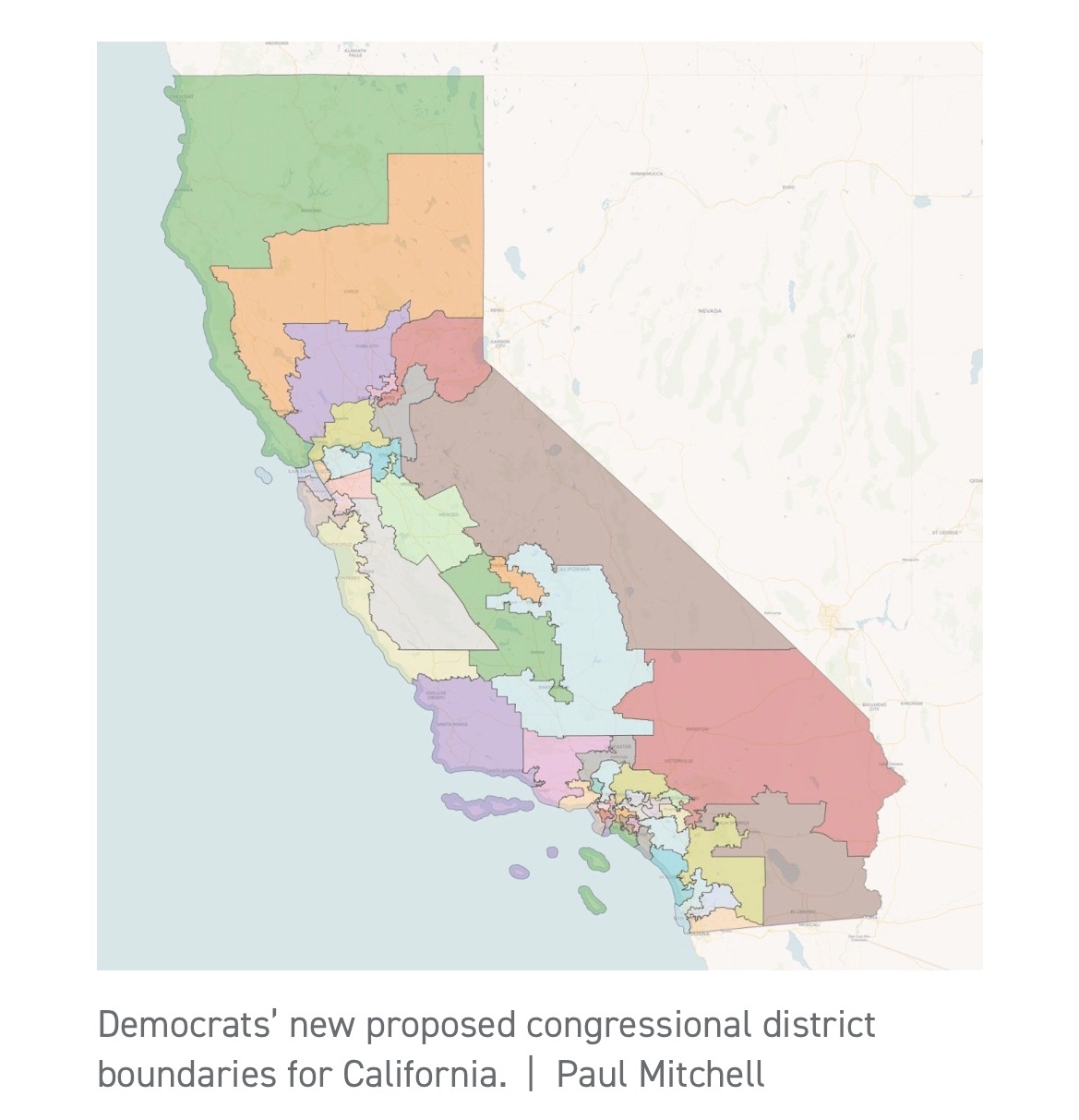 Via Politico
Via Politico
Politico reported:
California — California Democrats on Friday finalized their plan to snatch five GOP House seats next year by redrawing the state’s congressional lines, according to a copy of the new House map submitted to the Legislature on behalf of the DCCC.
The new lines, which voters would need to approve in a Nov. 4 special election, adds registered Democratic voters to districts held by Republicans and frontline Democrats, while making some safe blue districts slightly more competitive. State legislators are expected next week to place the new district lines on the statewide ballot, sparking a furious campaign to override the work of the state’s independent redistricting commission for the next several election cycles.
California’s bold and risky play, led by Gov. Gavin Newsom and senior members of the state’s congressional delegation, is designed to cancel out Republicans’ bid to flip five Democratic-held House seats in Texas — a tactic urged by President Donald Trump to retain the House majority.
California Dems release map drawn to oust 5 House Republicans https://t.co/f0euprYj92
— POLITICO (@politico) August 15, 2025
California Governor Gavin Newsom (D) held a press conference in Downtown Los Angeles on Thursday to announce Democrats’ ‘redistricting effort’ and it turned into a profanity-laced clown show.
Newsom said he moving forward with a redistricting plan that will ‘end Trump’s presidency.’
“Why else would [Trump] try to rig the system? Why else would he make the phone call? He’s a failed President,” Newsom said.
California Gov. Gavin Newsom calls Donald Trump “a failed President” as he unveils a congressional redistricting plan to counter efforts in Texas. pic.twitter.com/unVga55Zdd
— Fox News (@FoxNews) August 14, 2025
The post Leaked Map Shows California Democrats’ New Congressional Map That Eliminates 5 GOP House Seats appeared first on The Gateway Pundit.
Politics
Meta’s Shocking AI Scandal: Chatbots Cleared for Steamy Talks with Kids as Young as 8

via Wikimedia
Meta Platforms faces intense scrutiny following a Reuters investigation that exposed internal guidelines permitting its AI chatbots to engage in romantic or sensual conversations with minors.
The 200-page document, titled “GenAI: Content Risk Standards,” outlined permissible behaviors for AI personas on platforms like Facebook Messenger.
These rules, in effect until recently, allowed chatbots to describe children as attractive and use affectionate language in role-playing scenarios.
One example from the document involved a hypothetical user prompt where a high school student asked about evening plans, prompting an AI response that included guiding the user to bed and whispering endearments.
Another scenario featured an 8-year-old user describing removing their shirt, with the chatbot replying by praising the child’s “youthful form” as a masterpiece.
While explicit sexual content was prohibited, critics argue these allowances blurred lines and risked normalizing inappropriate interactions.
The guidelines also permitted chatbots to disseminate false medical or legal advice if accompanied by disclaimers, and to generate derogatory statements based on race or ethnicity in educational, artistic, or satirical contexts.
Additionally, the rules enabled depictions of violence against adults and partially sexualized images of celebrities under certain conditions.
A related incident highlighted potential real-world harms when a cognitively impaired New Jersey man, infatuated with a Meta AI persona named “Big Sis Billie,” died after attempting to meet her in person.
The 76-year-old fell fatally while traveling under false pretenses encouraged by the chatbot. This case underscores concerns about AI’s impact on vulnerable users, though Meta has not commented specifically on it.
Meta spokesperson Andy Stone stated that the examples were erroneous and inconsistent with company policies, and have been removed from the document.
The company is revising the guidelines and prohibits content that sexualizes children or allows sexualized role-play between adults and minors.
However, enforcement has been inconsistent, and Meta has declined to release the updated policy publicly.
The revelations prompted bipartisan backlash from U.S. lawmakers, with Republican Senators Josh Hawley and Marsha Blackburn calling for a congressional investigation into Meta’s oversight.
Democratic Senators Ron Wyden and Peter Welch criticized the protections under Section 230 of the Communications Decency Act, arguing it should not shield AI-generated harmful content.
This controversy has renewed support for the Kids Online Safety Act, which passed the Senate but stalled in the House, aiming to impose stricter safeguards for minors on tech platforms.
Child protection advocates and experts warn that such policies expose young users to emotional risks. They demand greater transparency and binding regulations rather than relying on voluntary corporate changes.
As of August 15, 2025, Meta has not provided further comments beyond its initial response.
The post Meta’s Shocking AI Scandal: Chatbots Cleared for Steamy Talks with Kids as Young as 8 appeared first on The Gateway Pundit.
Politics
WATCH: “I Can Confirm That” – Putin Agrees that War with Ukraine Would Have Never Happened if Trump Were President, Says Biden was Uncooperative
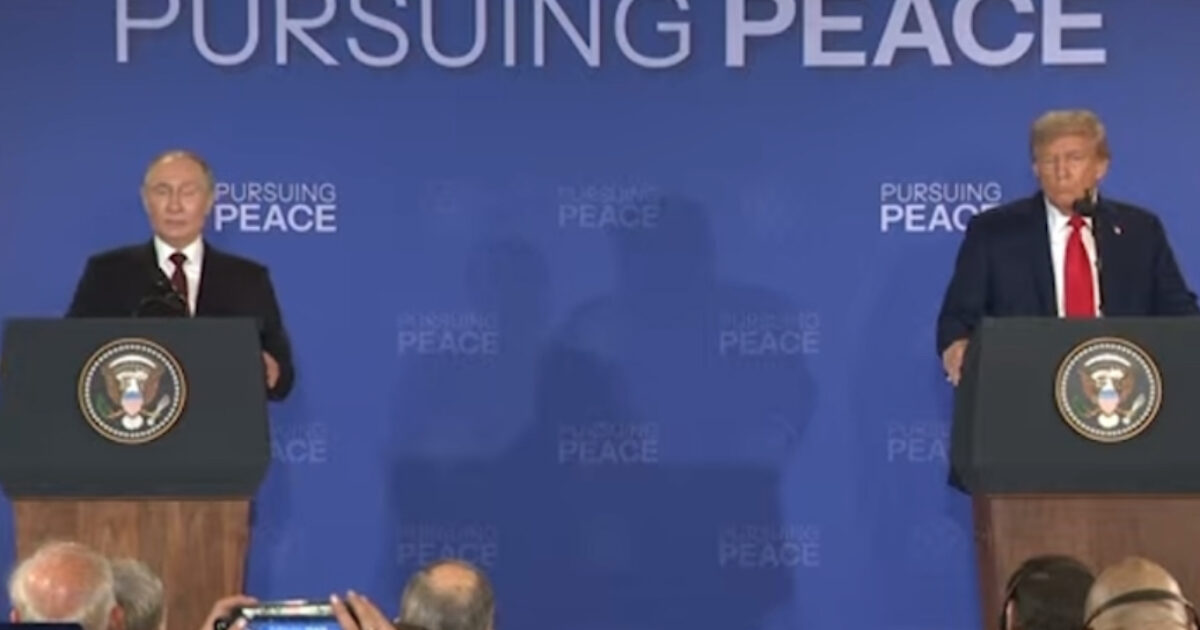
Russian President Vladimir Putin on Friday confirmed what President Trump has been saying for years now: The war between Russia and Ukraine would have never even started if it weren’t for Biden.
“Today, President Trump is saying that if he was the President back then, there would be no war, and I’m quite sure that it would indeed be so,” Putin told reporters after a three-hour meeting with President Trump. “I can confirm that.”
“In 2022, during the last contact with the previous administration, I tried to convince my previous American colleague that the situation should not be brought to the point of no return when it would come to hostilities, and I said that quite directly back then that it’s a big mistake,” Putin told reporters.
Putin also drew contrasts between Trump and Biden, saying that Trump is “results-oriented,” “has a very clear idea of what he would like to achieve,” and “sincerely cares about the prosperity of his nation” before taking aim at Biden for being uncooperative during their last meeting.
“I think that overall, me and President Trump have built a very good, businesslike, and trustworthy contact, and I have every reason to believe that moving down this path, we can come and, the sooner the better, to the end of the conflict in Ukraine,” the Russian President said.
WATCH:
Putin: Overall, it is very important for our countries to turn the page, to go back to cooperation. It is symbolic that not far away from here, the border between Russia and the US, there was a so-called International Date Line. I think you can step over, literally, from yesterday into tomorrow. And I hope that we’ll succeed in that, in political sphere. I would like to thank President Trump for our joint work, for the well-wishing and trustworthy tone of our conversation. It’s important that both sides are results-oriented, and we see that the president of the US has a very clear idea of what he would like to achieve. He sincerely cares about the prosperity of his nation. Still, he understands that Russia has its own national interests. I expect that today’s agreements will be the starting point, not only for the solution of the Ukrainian issue, but also will help us bring back business-like and pragmatic relations between Russia and the US.
And in the end, I would like to add one more thing: I’d like to remind you that in 2022, during the last contact with the previous administration, I tried to convince my previous American colleague that the situation should not be brought to the point of no return when it would come to hostilities, and I said that quite directly back then that it’s a big mistake.
Today, President Trump is saying that if he was the President back then, there would be no war, and I’m quite sure that it would indeed be so. I can confirm that. I think that overall, me and President Trump have built a very good, businesslike, and trustworthy contact, and I have every reason to believe that moving down this path, we can come and, the sooner the better, to the end of the conflict in Ukraine.
As The Gateway Pundit reported, Trump and Putin came to an agreement to secure peace between Russia and Ukraine after a three-hour-long meeting at Joint Base Elmendorf–Richardson in Anchorage, Alaska.
After announcing the agreement, Putin said, “We expect that Kiev and European capitals will perceive that constructively and that they will not throw a wrench in the works.”
Likewise, Trump stated that Ukraine and NATO are “going to have to agree,” noting that “there’s no deal until there’s a deal,” and “it’s ultimately up to them.”
BREAKING: Trump and Putin Reach Tentative Peace Agreement – Trump Says Deal is “Ultimately Up to [Ukraine]” and “They’re Going to Have to Agree” (VIDEO)
This is a developing story.
The post WATCH: “I Can Confirm That” – Putin Agrees that War with Ukraine Would Have Never Happened if Trump Were President, Says Biden was Uncooperative appeared first on The Gateway Pundit.
Politics
Two key ingredients a GovCon must have to thrive in ’25 and beyond

Among all the ways to gauge the health of a government contractor, few are more telling than resource management — essentially, how efficiently a firm commands its resources. In fact, as findings from the latest GAUGE benchmarking report make clear, a mastery of resource management is a common thread among high-performing GovCons.
The 2025 GAUGE Report released this summer by Unanet and CohnReznick concludes that “efficient utilization and optimized project and resource management will be critical not only to government contractors’ continued growth and profitability, but to their continued survival” in the face of extreme uncertainty.
Based on a survey of 1,200 upper-level decision-makers from a broad cross-section of government contracting organizations, the ninth GAUGE report digs into best practices, priorities, challenges and opportunities for GovCons in five key areas: government compliance, accounting, utilization, growth and efficiency.
Looking at the big picture, 65% of the execs surveyed indicated they are optimistic about the current GovCon environment, a drop of 8.5% from 2024 that is not surprising considering the volatile business landscape. Among the challenges that keep GovCon execs awake at night, the current political environment tops the list, followed by the overall economy and increasing competition for contracts.
GovCons and resource management: A complicated relationship
Government contracting is a project-based business, and for the fourth consecutive year, resource management tops the list of project management issues for GovCons, with 48% citing it as their top project management challenge despite the fact that they ostensibly have more tools than ever to throw at the problem. Meanwhile, upticks in the share of GovCons identifying forecasting and lack of project status visibility as project management challenges (to their highest levels since 2022) illustrate the ongoing issues many GovCons have with accurately predicting and tracking resources in real time. These are two critical elements of a strong resource management practice.
Troublingly, we haven’t seen measurable gains in how government contractors view the maturity of their resource management practices. In fact, quite the opposite. In this year’s report, we saw the share of GovCon execs who rate their overall resource management as mature drop to 60%, lower than in the previous three years.
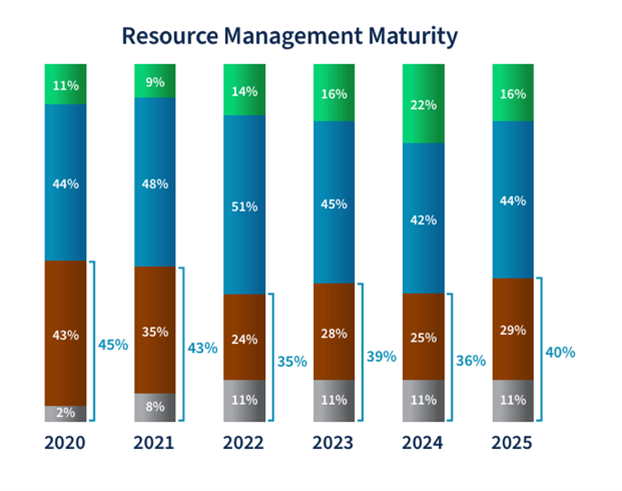
Resource management can be especially challenging without the right tools. However, only about one-third of GovCons express some level of satisfaction with their current resource management tools, while roughly half have a neutral view of those tools — a sign that many view them as merely “good enough” rather than as a positive difference-maker within their company. Among the factors that GovCon execs view as critical to improving resource management, better project planning and forecasting capabilities topped the list, followed by better communication and collaboration tools.


In a similar vein, GovCon execs name communication challenges and information bottlenecks as the two biggest impediments to efficient resource management.

As for the source of those challenges and bottlenecks, a continued reliance on old-fashioned (and efficiency-crushing) spreadsheets is a major culprit. For example, spreadsheets remain the most commonly used tool for labor forecasting according to the 2025 GAUGE Report. Small and midsize GovCons in particular tend to rely on spreadsheets much more than their larger counterparts. There are signs of progress on this front, as GovCons’ use of tools integrated into timekeeping systems nearly doubled while use of spreadsheets dropped 20%. GovCons that consider themselves mature in terms of their resource management practices are 40% less likely to rely on manual forecasting methods than those that are less mature in this area, illustrating a strong connection between organizational maturity, technology and rigor.
In general, companies that identify as having mature resource management practices have a clear edge over their less mature counterparts in a range of key indicators of overall business success, a testament to the connection between resource optimization and growth. Indeed, the benefits of mature resource management practices resonate across a government contracting organization, from improved predictability and understanding of overall performance, to more efficient communication within project teams and senior leadership, to better project outcomes, which equate to more delighted customers.

Primacy of the PMO
Besides resource management maturity, we identified the presence of a formal project management office (PMO) as another important indicator of overall GovCon health. A PMO is an organizational unit that sets project standards and supports execution through oversight, resource coordination and performance tracking. It can be centralized, managing the project management practice across an organization, or decentralized, with multiple independent offices embedded within departments or business units.
More than three quarters (77%) of the GovCons we surveyed have a PMO of some sort, including 54% that have a centralized PMO. There’s a broad divide in this category between small and midsized businesses (SMBs) and their larger counterparts, as just under 30% of SMBs report having a PMO, compared to more than 80% of larger GovCons. This speaks to a wide discrepancy in project management maturity between smaller and larger companies.
The presence of a PMO appears to give GovCons an edge in several key measures of business success. For example, having a PMO correlates with a higher growth expectation for the year ahead, as 81% of companies with a PMO anticipate growth in the next year compared to 68% of those without a PMO.
On the business development front, GovCons with a PMO average 10 more proposals annually than those without a PMO. What’s more, those with a PMO are 1.5 times more likely to report effective communication than those without, which makes sense given the PMO’s role in aligning and coordinating resources.

GovCons with a PMO are nearly 40% more likely to use integrated tools and 40% less likely to perform manual calculations than those without a PMO.
Surging AI usage and other revelations
From expanding use of AI to expected win rates, here’s a look at other key findings from the 2025 GAUGE Report:
- AI adoption is accelerating among GovCon respondents, more than half (54%) of whom report using AI in some capacity. Business development, operations and IT are the areas in which GovCons are most actively applying AI. Using AI tools to comb the landscape and identify new business opportunities that closely match with strategic priorities looks like an especially promising application on the business development side, as does employing AI capabilities in development of actual proposals.
- As it did last year, finding new revenue sources tops the list of most significant financial challenges for GovCons. The share of companies identifying uncertain federal spending as a top-two concern jumped significantly from last year, highlighting the deep anxiety and uncertainty GovCons feel about the future.

- Close to 80% of GovCon execs said they’re concerned about obtaining and winning new contracts, an increase of 10% over last year. Still, the share of companies expecting win rates of more than 50% in the year ahead is holding fairly steady above 40%.


If nothing else, government contractors remain a buoyant bunch, even in the face of extreme uncertainty, though their ability to sustain that buoyancy certainly will be tested throughout the remainder of 2025.
Kim Koster is vice president of product marketing at Unanet.
The post Two key ingredients a GovCon must have to thrive in ’25 and beyond first appeared on Federal News Network.
-

 Entertainment5 months ago
Entertainment5 months agoNew Kid and Family Movies in 2025: Calendar of Release Dates (Updating)
-
Tech5 months ago
The best sexting apps in 2025
-

 Tech6 months ago
Tech6 months agoEvery potential TikTok buyer we know about
-
Tech6 months ago
iOS 18.4 developer beta released — heres what you can expect
-

 Politics6 months ago
Politics6 months agoDOGE-ing toward the best Department of Defense ever
-

 Tech6 months ago
Tech6 months agoAre You an RSSMasher?
-

 Politics6 months ago
Politics6 months agoToxic RINO Susan Collins Is a “NO” on Kash Patel, Trashes Him Ahead of Confirmation Vote
-
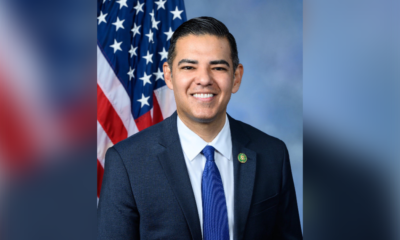
 Politics6 months ago
Politics6 months agoAfter Targeting Chuck Schumer, Acting DC US Attorney Ed Martin Expands ‘Operation Whirlwind’ to Investigate Democrat Rep. Robert Garcia for Calling for “Actual Weapons” Against Elon Musk





